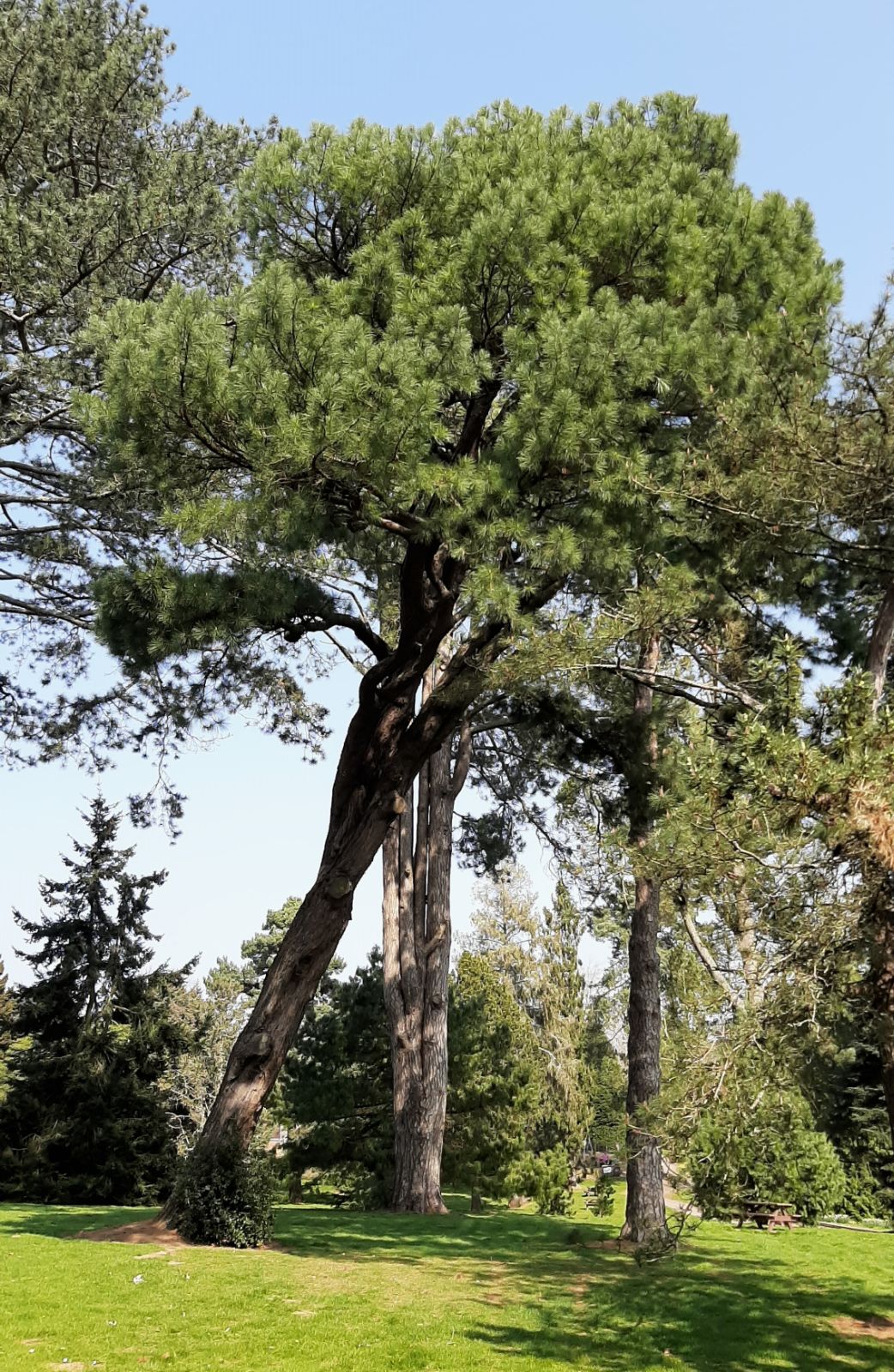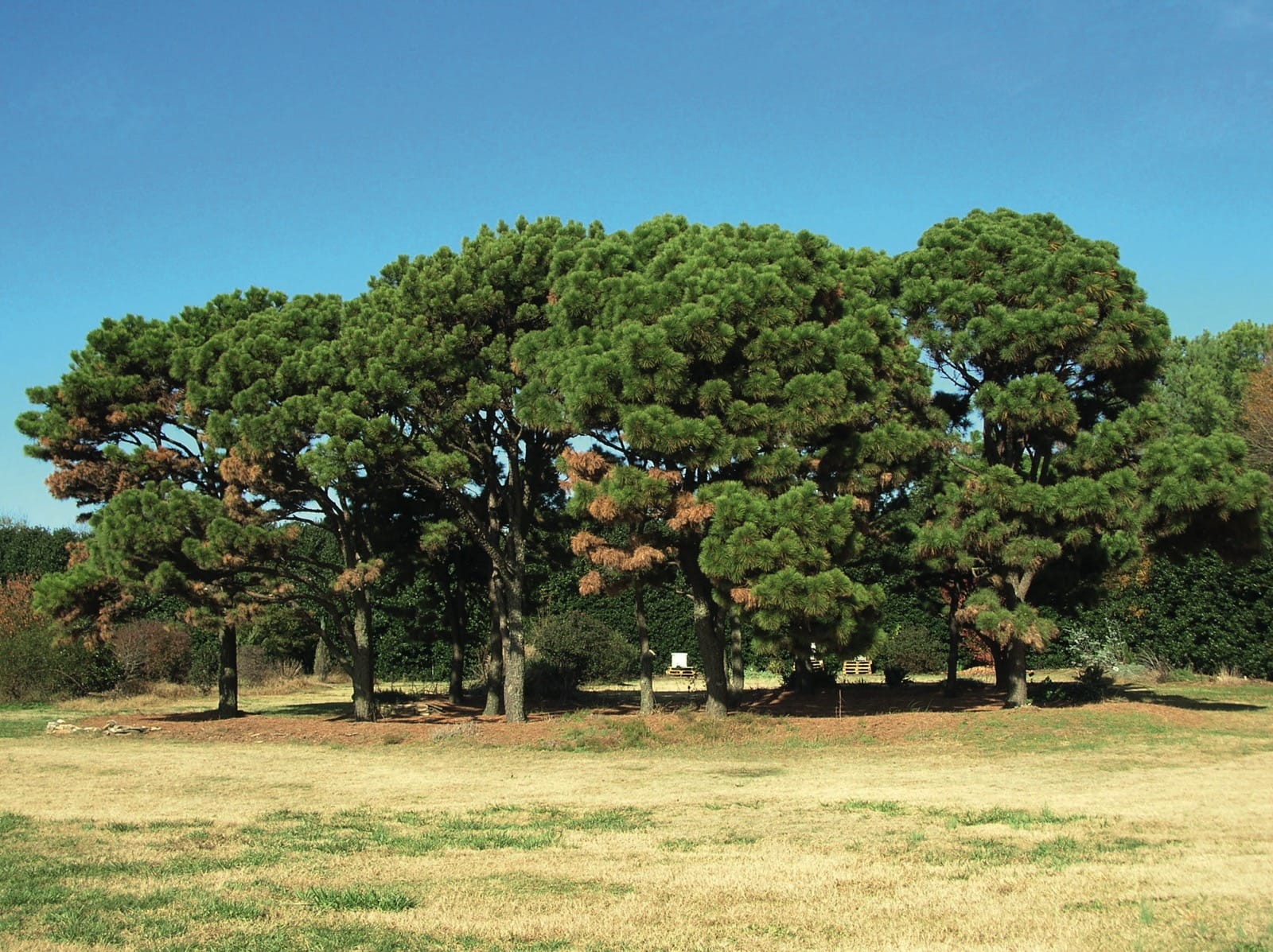Pinus taeda
Credits
Article from New Trees by John Grimshaw & Ross Bayton
Recommended citation
'Pinus taeda' from the website Trees and Shrubs Online (treesandshrubsonline.
Genus
- Pinus
- Subgen. Pinus, Sect. Trifolius
Common Names
- Loblolly Pine
Other taxa in genus
- Pinus albicaulis
- Pinus arizonica
- Pinus armandii
- Pinus attenuata
- Pinus ayacahuite
- Pinus balfouriana
- Pinus banksiana
- Pinus bhutanica
- Pinus brutia
- Pinus bungeana
- Pinus canariensis
- Pinus cembra
- Pinus cembroides
- Pinus chiapensis
- Pinus contorta
- Pinus coulteri
- Pinus culminicola
- Pinus densata
- Pinus densiflora
- Pinus devoniana
- Pinus durangensis
- Pinus echinata
- Pinus edulis
- Pinus elliottii
- Pinus engelmannii
- Pinus eremitana
- Pinus flexilis
- Pinus gerardiana
- Pinus greggii
- Pinus × hakkodensis
- Pinus halepensis
- Pinus hartwegii
- Pinus heldreichii
- Pinus henryi
- Pinus × holfordiana
- Pinus hwangshanensis
- Pinus jeffreyi
- Pinus johannis
- Pinus koraiensis
- Pinus lambertiana
- Pinus leiophylla
- Pinus longaeva
- Pinus massoniana
- Pinus maximartinezii
- Pinus monophylla
- Pinus montezumae
- Pinus monticola
- Pinus morrisonicola
- Pinus mugo
- Pinus muricata
- Pinus nelsonii
- Pinus nigra
- Pinus oocarpa
- Pinus orizabensis
- Pinus palustris
- Pinus parviflora
- Pinus patula
- Pinus peuce
- Pinus pinaster
- Pinus pinceana
- Pinus pinea
- Pinus ponderosa
- Pinus pseudostrobus
- Pinus pumila
- Pinus pungens
- Pinus quadrifolia
- Pinus radiata
- Pinus remota
- Pinus resinosa
- Pinus rigida
- Pinus roxburghii
- Pinus sabiniana
- Pinus serotina
- Pinus sibirica
- Pinus strobiformis
- Pinus strobus
- Pinus sylvestris
- Pinus tabuliformis
- Pinus taiwanensis
- Pinus teocote
- Pinus thunbergii
- Pinus torreyana
- Pinus virginiana
- Pinus wallichiana
- Pinus wangii
- Pinus yunnanensis
Tree to 45 m, trunk straight, erect or slightly crooked, 0.5–1 m dbh. Bark thin, scaly, blackish; in mature trees reddish brown to grey, breaking into flat, rectangular plates separated by longitudinal fissures. Crown dense and compact, rounded. Branchlets glabrous, yellowish brown, slender to stout; vegetative buds not resinous. Leaves in fascicles of (two to) three (to four), persisting for three to four years, long, slender, stiff, sometimes slightly twisted, pale green, triangular in cross-section, 15–22 cm long, apex acute. Fascicle sheaths 2.5 cm long, persistent. Cataphylls brown, deciduous. Male strobili yellow, cylindrical, 1.5–3 cm long. Female cones subterminal, solitary, sessile or with a short peduncle; cone 5–12(–15) cm long, yellow-buff to grey-buff, mature in about 18 months; mature cones ovoid-cylindrical, sometimes leaving basal scales attached to branchlets when falling. Scales 110–140; apophysis flattened or wrinkled; umbo dorsal, armed with a sharp, stout spine. Seeds dark brown with black dots; wings effective, 2–2.5 cm long. Thieret 1993, Farjon 2005a. Distribution USA: Alabama, Arkansas, Delaware, northern Florida, Georgia, Louisiana, Maryland, Mississippi, southern New Jersey, North Carolina, southeast Oklahoma, South Carolina, southern Tennessee, eastern Texas, Virginia. Pinus taeda is an aggressive coloniser of secondary habitat, and has escaped from plantations in many countries where it is planted for timber. Habitat Flatlands and rolling hills between 0 and 700 m asl. USDA Hardiness Zone 6. Conservation status Lower Risk. Illustration Farjon 2005a; NT624. Cross-reference K245. Taxonomic note Pinus taeda forms a natural hybrid (P. ×sondereggeri) with P. palustris Mill. where their ranges overlap.
Of all the American East Coast pines, Pinus taeda has the widest range. It was introduced to England by Bishop Compton before 1713 and has been in continuous cultivation since then (Elwes & Henry 1910), so its omission by Bean (1976b) is rather curious. It grows reasonably well in southern England and forms an attractive rather bushy-looking canopy, but inadequate summer heat sometimes manifests itself in slow growth and crooked stems, and in the cones being small (under 8 cm) and not maturing properly. There are specimens in several collections, including trees of 15 m or more at Kew, Bicton, Wakehurst Place and Bedgebury. In continental Europe it is not frequently grown, although it has the potential to flourish in many areas. It does very well around Bordeaux, for example (Elwes & Henry 1910). In the eastern United States it is too conspicuous and frequent in the countryside to be particularly desirable as a garden specimen, although it is often planted by landscapers (Dirr 1998). It certainly thrives as far north as Philadelphia, where a 15-year-old specimen at the Scott Arboretum was 12 m tall in 2006.
By far the most interesting and horticulturally useful versions of P. taeda are the dwarf trees growing principally at the JC Raulston Arboretum. ‘Dwarf’ is a misleading term in this case, as it suggests a low bushy plant. These, rather, are slow-growing short trees with dense rounded heads: ‘semi-dwarf’ might be a better designation for them. J.C. Raulston himself (1987) wrote up their history and attributes: ‘Among the finest plants in the NCSU Arboretum is a group of about forty-five 30 year-old [sic] dwarf loblolly pines which arose as seedlings from witches broom cones originally collected by university forestry researchers. The slow growing seedlings now vary in size from 8’ to 15’ in height [2.4–4.6 m] with beautiful dense rounded crowns. Few dwarf pine cultivars are well adapted to the heat of the south and these pines would be magnificent ornamentals if commercially produced. Unfortunately [they] must be produced by side-veneer grafting on seedling loblolly pine understock. Southern growers do not graft conifers, and the northern growers who do graft pines do not have easy access to either understock or stock plants to produce the plants, so they remain unavailable. Perhaps one of the most beautiful and useful potential landscape plants in existence for southern gardens …’
Several accounts of the origin of these exceptional pines have circulated, but the definitive version is provided in a master’s thesis by a North Carolina State University student, Gery Allan Glover (Glover 1987), summarised here by Bobby Ward (pers. comm. 2007): ‘The seed from which they were grown was collected from a witch’s broom in a single tree in Virginia in 1964, as part of a NCSU Tree Improvement Program directed by Dr. John Duffield (NCSU Forestry Department). The seeds were germinated by James Cunningham, as an undergraduate research project. Duffield was interested in producing dwarfing rootstocks for loblollies for possible candidate Christmas tree production. At the conclusion of the Duffield-Cunningham project (apparently only a year or so later), Duffield offered plants to Dr. Fred Cochran (NCSU Horticulture Department). Cochran took cuttings from two-year old individuals that exhibited the dwarf habit in 1966, which at the time were 12 to 14 inches tall, compared to normal trees from the same seed lot which were then 3 to 4 feet tall.’
It was the trees raised from these cuttings (the seedlings themselves were destroyed) that were planted on and around the current JC Raulston Arboretum site and elsewhere (Glover 1987), though some were subsequently transplanted from their original positions by J.C. Raulston. By 2007 they had reached heights of between 4.6 and 6 m and developed rounded crowns 4–4.6 m wide. There is slight variation in stature between the individuals. Clonal propagation is limited by the difficulty of grafting mature growth, but seed raised from these trees gives about 20 per cent dwarf seedlings, recognisable after 4–5 months of growth. A batch of such seedlings raised at the JC Raulston Arboretum in 2006 has been distributed to nurserymen and other gardens. Cuttings from seedlings can be rooted, and juvenile material grafts more easily (D. Werner, pers. comm. 2007). It is to be hoped that this will lead to their more widespread distribution in the southeastern United States, as J.C. Raulston wished to see. Prior to this, the only commercial distribution of this unusual form was a limited release of grafted trees in 2004 by Yucca Do Nursery, Hempstead, Texas, under the name ‘J.C. Raulston’ – although these were not propagated from a single clone (T. Doremus, pers. comm. via B. Ward 2007). (This paragraph was compiled from information provided by T. Avent, L. Hatch (including his New Ornamentals Society website, on P. taeda: Hatch 2005), B. Ward and D. Werner.)
The trees at the JC Raulston Arboretum have been known collectively as P. taeda ‘Nana’, but as this is a post-1959 name it is invalid under the Cultivated Plant Code. Since the trees form a population with shared characters they should be treated as a cultivar group. The name Pinus taeda NCSU Dwarf Group has been proposed for them by Larry Hatch (2005), via the website of the New Ornamentals Society, and is adopted here with the approval of Dr Dennis Werner, Director of the JC Raulston Arboretum. This name covers all the ‘dwarf’ trees at and around the JC Raulston Arboretum and their progeny. The plants distributed by Yucca Do as ‘J.C. Raulston’ should be regarded as part of the NCSU Dwarf Group. Other dwarf selections from witches’ brooms, however, such as ‘Little Albert’, distributed by Louisiana Nursery as grafted specimens, should not be considered part of the NCSU Dwarf Group.






